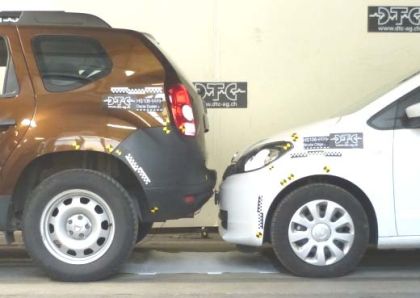More information
Main author
Murri, R.
Co-Authors
Gerster, B.; Soltermann, B.; Muser, M.; Eichholzer, T.; Keusch, T.; Martelozo, L.
Type of media
Publication type
Lecture
Publication year
2014
Publisher
23. EVU Conference, Copenhagen
Citation
Murri, R.: New development of front and rear ends of actual cars
 In behalf of the SIA (Swiss Insurance Association) the DTC Dynamic Test Center AG in Vauffelin, Switzerland, performed during the last ten years more than 100 vehicle-to-vehicle collisions at low crash velocity. The crash results are published free of charge on the website of AGU (Working group on accident mechanics) to provide assistance to the accident analytics in whiplash cases. As additional results of the performed crash tests a considerable amount of new cars could be tested concerning new materials, specialties and interactions with other cars.
In behalf of the SIA (Swiss Insurance Association) the DTC Dynamic Test Center AG in Vauffelin, Switzerland, performed during the last ten years more than 100 vehicle-to-vehicle collisions at low crash velocity. The crash results are published free of charge on the website of AGU (Working group on accident mechanics) to provide assistance to the accident analytics in whiplash cases. As additional results of the performed crash tests a considerable amount of new cars could be tested concerning new materials, specialties and interactions with other cars.
The survey showed that the material diversity of front and rear end constructions increases (different metals, metal foams, synthetic materials, synthetic foams, glass reinforced plastic GRP, carbon fiber reinforced plastic CFRP …). Generally the stiffness of structure increases, including a soft front area for pedestrian safety. The pedestrian safety structure is so soft, that used cars often had previous damages. By the performed crash tests already at this low impact velocity, severe damage on the front ends arises. The rear end constructions become stiffer at certain points. This stiffness results also in stronger damages on front structures and a higher velocity change for the pushed car. It has been noted, that some constructions were designed asymmetric for a good performance in standardized crash tests. As consequence, as example for the AZT crash, some structures are strong on the left sides and soft on the right side. Due to the higher degree of stiffness, especially in rear end construction, the probability of belt pretensioner and airbag ignitions increase even by collisions with low impact velocity. Several airbag ignitions on colliding cars by a velocity change below 20 km/h were observed. With every airbag ignition in low velocity collisions result a higher risk of injury and higher additional costs.